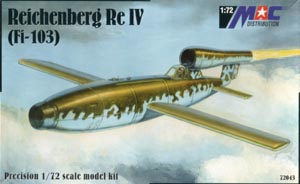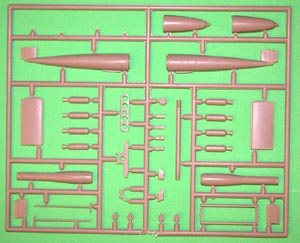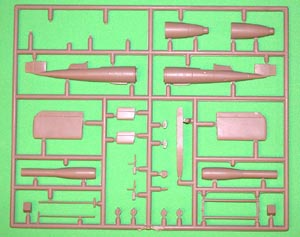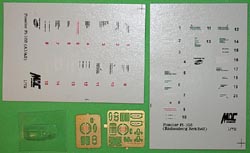Mac Models’ 1/72 Reichenberg Re IV &
Fieseler Fi 103
|
 |
History
You’d be hard pressed to find someone in this hobby that hasn’t heard
of the V-1, or Buzz Bomb. Hundreds of these weapons were launched against
cities in the British Isles, falling to targets
basic guidance. This last aspect resulted in one of the more interesting
modifications to the airframe, this being the addition of a cockpit and
pilot’s controls. The resultant aircraft was designed to be dropped from
a parent plane (the Heinkel He 111) and then steered to the target. Once
the target was lined up and it would be impossible to miss, the pilot
would then bail out of the plane, leaving it to destroy its target. Realistically,
though, the chances of the pilot getting out and surviving were very slim,
but there had to be at least a glimmer of hope to get pilots to fly the
planes.
Over 150 Fi 103s were built, but none were used operationally. It is
uncertain how many V-1s were built, but it was well into the hundreds.
 The
Kits The
Kits
These two kits are very similar but have obvious differences. At first
glance they seem to share the same trees, but close examination shows
that the differences incorporated in the Fi 103 require more parts as
well as different wings and tail surfaces. While the trees are different,
construction is pretty much the same for both.
Since the Fi 103 has an interior, we’ll take a look at that first.
The canopy on this plane is quite small and covers a small opening, so
there’s not much to see here. The kit comes with a seat and instrument
panel in plastic, with photoetched seatbelts and rudder pedals, as well
as an instrument panel to overlay the plastic one. Once this is done
the rest of the construction is the same for both kits.
 The
fuselage is split into four pieces, with the rear section including the
rear fin and front engine mounting pylon. The engine itself is split
in right and left halves, with a choice of either a plastic front or an
etched brass front. The wings and horizontal tailplanes are molded as
right and left pieces, with the Fi 103 incorporating the trailing edge
control surfaces. Rounding out the plastic parts are components to make
up a wheeled cart to display the finished model on, a nice touch since
the aircraft has no landing gear. The
fuselage is split into four pieces, with the rear section including the
rear fin and front engine mounting pylon. The engine itself is split
in right and left halves, with a choice of either a plastic front or an
etched brass front. The wings and horizontal tailplanes are molded as
right and left pieces, with the Fi 103 incorporating the trailing edge
control surfaces. Rounding out the plastic parts are components to make
up a wheeled cart to display the finished model on, a nice touch since
the aircraft has no landing gear.
The decals are quite simple and provide lots of little stencils, which
are pretty much all these little guys ever wore. The Reichenberg IV has
four options depicted in the instructions: one overall black, one overall
RLM 71, and two RLM 71 over RLM 65. The second 71/65 scheme has the aft
sections of the wings and tailplanes painted in white, with the rudder
split black/white. The front of the engine is bare aluminum, resulting
in a rather interesting example.
 Four
examples are in the Fi 103 as well, with much more variety here. The
first is RLM 74 over RLM 76, with the upper surface camouflage painted
on in a rough pattern. The second is RLM 71 over RLM 65 in a simple pattern.
An interesting scheme is the one that has RLM 75 over RLM 02, with sections
of the upper fuselage mottled rather than solid. The last scheme is probably
the most interesting. The majority of it is painted RLM 76, with one
fuselage section having the upper surfaces painted RLM 75. The front
of the engine is also RLM 75, while the rest of the upper surfaces are
covered with RLM 72 squiggles. Four
examples are in the Fi 103 as well, with much more variety here. The
first is RLM 74 over RLM 76, with the upper surface camouflage painted
on in a rough pattern. The second is RLM 71 over RLM 65 in a simple pattern.
An interesting scheme is the one that has RLM 75 over RLM 02, with sections
of the upper fuselage mottled rather than solid. The last scheme is probably
the most interesting. The majority of it is painted RLM 76, with one
fuselage section having the upper surfaces painted RLM 75. The front
of the engine is also RLM 75, while the rest of the upper surfaces are
covered with RLM 72 squiggles.
Conclusion
These are nice little kits with simple construction, making them a great
weekend project. The inclusion of the dolly and the interesting color
schemes will result in a nice addition to any WW2 model collection.
|








|

 The
Kits
The
Kits The
fuselage is split into four pieces, with the rear section including the
rear fin and front engine mounting pylon. The engine itself is split
in right and left halves, with a choice of either a plastic front or an
etched brass front. The wings and horizontal tailplanes are molded as
right and left pieces, with the Fi 103 incorporating the trailing edge
control surfaces. Rounding out the plastic parts are components to make
up a wheeled cart to display the finished model on, a nice touch since
the aircraft has no landing gear.
The
fuselage is split into four pieces, with the rear section including the
rear fin and front engine mounting pylon. The engine itself is split
in right and left halves, with a choice of either a plastic front or an
etched brass front. The wings and horizontal tailplanes are molded as
right and left pieces, with the Fi 103 incorporating the trailing edge
control surfaces. Rounding out the plastic parts are components to make
up a wheeled cart to display the finished model on, a nice touch since
the aircraft has no landing gear. Four
examples are in the Fi 103 as well, with much more variety here. The
first is RLM 74 over RLM 76, with the upper surface camouflage painted
on in a rough pattern. The second is RLM 71 over RLM 65 in a simple pattern.
An interesting scheme is the one that has RLM 75 over RLM 02, with sections
of the upper fuselage mottled rather than solid. The last scheme is probably
the most interesting. The majority of it is painted RLM 76, with one
fuselage section having the upper surfaces painted RLM 75. The front
of the engine is also RLM 75, while the rest of the upper surfaces are
covered with RLM 72 squiggles.
Four
examples are in the Fi 103 as well, with much more variety here. The
first is RLM 74 over RLM 76, with the upper surface camouflage painted
on in a rough pattern. The second is RLM 71 over RLM 65 in a simple pattern.
An interesting scheme is the one that has RLM 75 over RLM 02, with sections
of the upper fuselage mottled rather than solid. The last scheme is probably
the most interesting. The majority of it is painted RLM 76, with one
fuselage section having the upper surfaces painted RLM 75. The front
of the engine is also RLM 75, while the rest of the upper surfaces are
covered with RLM 72 squiggles.





